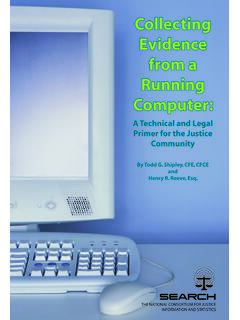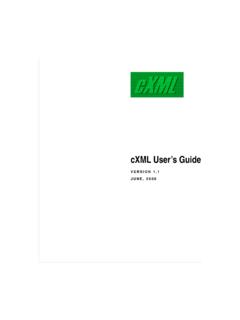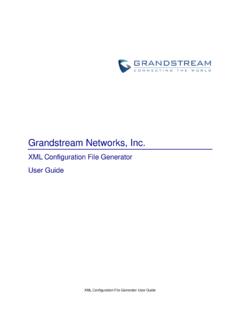Transcription of Building Exchange Content Using the Global Justice XML ...
1 Building Exchange Content Using theGlobal Justice XMLData Model:A user guide forPractitioners and DevelopersSEARCHD eveloped in partnership with SEARCH,The National Consortium for Justice Information and Department of JusticeOffi ce of Justice ProgramsBureau of Justice Assistancei Department of Justice Office of Justice Programs Bureau of Justice AssistanceBuilding Exchange Content Using theGlobal Justice XMLData Model:A user guide forPractitioners and Developers* * *This document was prepared under the leadership, guidance, and funding of the Bureau of Justice Assistance (BJA), Office of Justice Programs, Department of Justice in collaboration with SEARCH, The National Consortium for Justice Information and Statistics.
2 This project was supported by Award No. 2003-DD-BX-K014, awarded by the Bureau of Justice U. S. Department Of JusticeBureau of Justice AssistanceDear Colleague:The Department of Justice Global Justice Information Sharing Initiative and the resulting product, the Global Justice XML Data Model (GJXDM), represent an unprecedented government paradigm. Not only is GJXDM the result of a true partnership among local, state, and federal practitioners, but it is also the result of an extraordinary collaboration with industry and the private sector. Most important, GJXDM was developed from the ground up by local GJXDM on this local vision is critical to the effectiveness and success of the initiative. While I am currently the Director of the Office of Justice Programs Bureau of Justice Assistance, my nearly 20 years of Justice experience at the state and local level reinforce two axioms: that local control must be at the core of every new policy and product, and collaborations provide insight and a network for long-lasting change.
3 Once a vision, Global Justice XML is now a reality in Pennsylvania s Justice Network (JNET) system; in Maricopa County, Arizona; in Los Angeles s and Southern California s regional information sharing; in the Wisconsin Justice Information Sharing Initiative (WIJIS) Gateway project; in my home state of Ohio; and in many other jurisdictions across March 2005, this information-sharing initiative expanded to a new collaboration between the Department of Justice and the Department of Homeland Security. Recognizing that critical data regarding offenders and crimes is often local information, local agencies have begun adopting the model and can now share information more effectively than ever before. Placing the right information in the right hands at the right time is a powerful resource in the collective fight against terrorism and the novice user to the experienced technology practitioner, the Global Justice XML user guide provides clear and consistent guidelines for GJXDM implementation, as well as reference architecture and best practices that have evolved since GJXDM s release in 2004.
4 Still in the early stages of information sharing, we are nonetheless ahead of the curve and setting a new course for future generations. Domingo S. HerraizDirectorBureau of Justice AssistanceJune 2005iiiContentsAcknowledgments ..ivExecutive Summary ..vIntroduction:What This user guide Is and Why It Is Important Now ..1 Module 001:Background/Overview of Global Justice XML Data Model DevelopmentPart 1 General Overview ..4 Part 2 Enterprise Architectural Overview ..14 Module 002:General Object-oriented and XML ConceptsPart 1 Overview of the Global Justice XMLData Model Framework ..17 Part 2 Properties and Types ..25 Part 3 XML Schema Definition Standard ..30 Part 4 Global Justice XML Data ModelNaming Conventions ..32 Part 5 Namespaces ..36 Part 6 Metadata ..40 Module 003: Global Justice XML Data Model ContentPart 1 Architecture of the Global JusticeXML Data Model.
5 50 Part 2 Global Justice XML Data DictionaryCore Components ..52 Part 3 Metadata in the Global Justice XMLData Model ..59 Part 4 Code Tables and Enumerations inthe Global Justice XML Data Model ..63 Part 5 XML Schema Elements VersusAttributes ..67 Part 6 Global Justice XML Data Model DocumentType ..70 Module 004: Using the Global Justice XML Data Model To Describe Real-life Justice DataPart 1 Exchange Document Development Process ..74 Part 2 Exchange Document ProjectInception ..76 Part 3 Domain Modeling ..79 Part 4 Domain- Global Justice XMLData Model Mapping ..86 Part 5 Schema Building ..89 Part 6 Building Schema-valid Instancesand Packaging ..103 Module 005: Global Justice XML Data Model Use Cases for Justice and Public SafetyPart 1 Field Interview Report.
6 104 Part 2 Incident Report ..109 Part 3 Sentencing Order ..118 Part 4 Uniform Rap Sheet ..121 Module 006: Global Justice XML Data Model Funding and ConformancePart 1 Funding Requirements: Departmentof Justice and Department of HomelandSecurity Special Conditions ..125 Part 2 Global Justice XML Data Model Conformance Guidelines ..127 Part 3 Global Justice XML Data Model Conformance guide for the Practitioner ..129 Appendix 1: Global Justice XML Data Model Feedback, Release Process, and Documentation ..131 Appendix 2: Global Justice XML DataModel Tools and Resources ..136 Appendix 3: Glossary of Justice and Information Technology Terms ..141 Appendix 4: Global Justice XML DataModel Partners ..154ivAcknowledgmentsThe Bureau of Justice Assistance (BJA) would like to thank the following members of SEARCH, The National Consortium for Justice Information and Statistics, for their dedication in producing this document:Francis X.
7 Aumand III, ChairRonald P. Hawley, Executive DirectorKelly J. Harris, Deputy Executive DirectorCatherine Plummer, Justice Information Systems SpecialistTwyla R. Putt, Manager, Corporate CommunicationsJane L. Bassett, Publishing SpecialistThis user guide would not have been possible without the significant contribution of the engineers at the Georgia Tech Research Institute, who developed much of the technical Content for this also acknowledges members of the Global XML Structure Task Force, who continue to guide the development of the Global Justice eXtensible Markup Language Data Model (GJXDM).Last, but not least, BJA extends its thanks to the members of the GJXDM user guide Review Committee, a small cadre of Justice practitioners with direct experience in the implementation of GJXDM.
8 Their contribution to the successful completion of this guide is very much user guide Review CommitteeScott CameJustice Integration SolutionsJeff HarmonMaximusGerry ColemanWisconsin Department of JusticeKen BoucheIllinois State PolicePam ScanlonAutomated Regional Justice Information System (ARJIS)Steve PrisocNew Mexico Supreme CourtJohn Ruegg Los Angeles County (California) Information Systems Advisory Body (ISAB)Robin GibsonMissouri Office of the State Court AdministratorMark KindlGeorgia Tech Research Institute (GTRI)Joe MierwaVisionAirWinfield WagnerCrossfloJim Cabral and Ellen PerryMTG Management ConsultantsPaul EmbleyGlobal XML Structure Task Force (XSTF)vExecutive SummaryAccurate and germane sharing of information across jurisdictions is a critical issue for Justice and public safety.
9 Although there has been significant progress in the field of information technology, the lack of standards for exchanging Justice data has not only been a major obstacle to, but also the principal reason for, the high costs involved with Justice information Exchange . The development of the Global Justice XML Data Model (GJXDM) represents a significant achievement in the process of developing standards for sharing Justice to the success of the Global Justice XML standards effort is the promulgation of written guidelines to facilitate GJXDM implementation by the Justice community. In FY 2004, the Bureau of Justice Assistance (BJA) awarded SEARCH with a grant to provide Global Justice XML technology assistance, including the development of a user guide to support the implementation of the inception of this project, BJA has recognized the importance of including input from practitioners and developers currently implementing Justice exchanges Using the GJXDM components.
10 With that objective in mind, BJA, with support from SEARCH, established a GJXDM user guide Review Committee, comprised of a focused group of subject-matter and industry experts who have helped to determine the outline of user guide Content , reviewed user guide chapters as they were developed, and provided written material and comments throughout the process. The Review Committee was integral to the development of this its experience in providing technical assistance over the past year, BJA discovered that agencies and jurisdictions throughout the nation are at varying stages of readiness to implement GJXDM. Some Justice agencies are just beginning the process of evaluating and exploring XML as a technology. They need to begin to develop a local knowledge base about GJXDM and its impact on supporting interoperability among Justice , public safety, and related systems.














